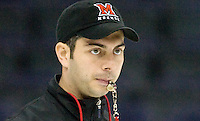Hockey has a distinct hierarchy and whatever happens at the top affects everyone else in some way. One needs to look only at the results of the 2004-05 NHL lockout that brought sweeping changes to hockey’s entire landscape.
In addition to new on-ice rules, there were many changes to how players’ contracts could be structured, when players could sign and how much they could be paid on entry-level deals within the new collective bargaining agreement. As a result, the NHL got younger in a hurry, which has had a lasting impact on college hockey.
“When they made the last agreement, they felt the rule that they put in place was going to benefit college hockey, but unfortunately it didn’t do that,” Wisconsin coach Mike Eaves said. “It definitely hurt our game because players are leaving earlier and there was a higher turnover ratio.”
“I think when the CBA came out the first time around, the general managers tried to think about college hockey and they thought it would actually be a benefit,” Miami coach Enrico Blasi said. “In reality it hasn’t been a benefit. You just don’t know the consequences until you dive into what exactly the process is and all the stuff that’s going on.”
Among the unintended consequences, the NHL’s entry-level contract structure made it more appealing to sign players younger and also made college free agents more attractive to sign. Additionally, the NHL shortened its draft from nine rounds to seven, which left more college players without draft rights tying them to a team and thus made for even more college free agents available.

“As they move forward, we certainly hope and would speculate that [both parties] would do things that will help our game or at least have [college hockey] in their mind when they make these rules.”
— Wisconsin coach Mike Eaves
Just as the 2004-05 lockout brought sweeping changes, the current CBA negotiations between the NHL and NHLPA could bring more changes.
According to Nate Ewell, director of communications for College Hockey Inc., the negotiations are something all of college hockey will be watching closely.
“Anything that changes at the NHL level is bound to have an impact on the development levels and we certainly saw that in the last CBA,” Ewell said. “We’re anxious to see how it turns out.”
Though college hockey doesn’t have direct involvement with the negotiations, College Hockey Inc., then under the direction of former NHLPA executive director Paul Kelly, brought a group of coaches together with NHL general managers and administrators during the 2011 Stanley Cup Final in Boston.
“[The general managers] were interested in the issues colleges are facing,” Ewell said. “They certainly listened and considered everything fairly. [NHL commissioner] Gary Bettman is obviously interested in seeing college hockey succeed, because it helps his sport.”
Among the changes, coaches expressed a desire for a deadline by which NHL teams would have to sign a player currently enrolled in school. Specifically, the group pointed to the June 15 deadline within the current CBA for signing players under contract with European clubs as a template for such a change.
Eaves, who was one of the coaches in Boston, addressed that ruling specifically.
“That was impacting college hockey because we were losing kids in July and August,” said Eaves, a former NHL player. “Where are you going to find a college hockey player at that time? Well, you’re not.
“We want to piggyback off [the European] ruling if [players are] not signed by June 15, then they could not be signed. The precedent had already been set with European players.”
Late signings, though few and far between, impact not only college hockey but trickle down to the feeder systems like the USHL.
Additionally, when a college player signs late, the schools sometimes have to bring in a player before they planned to, and sometimes before that player is ready for college hockey.
“It isn’t helpful for the player that has to be brought into the school a year early and it sort of wreaks havoc with the number of levels in the development system,” Ewell said. “That’s something we’ve asked GMs to consider. We’re asking them to give up an option that they have, but I think they understand the reasoning behind it.”
In addition to the signing deadline, Ewell expressed the desire to see some alterations to the NHL entry draft.
“I think looking at the draft is foremost in our minds from a college standpoint because that’s where you can have the biggest effect,” he said. “There’s a number of different ways the CBA could address that.”
The now-expired CBA calls for a seven-round draft and includes players who will turn 18 by Sept. 15 of the following season and any other player who has played at least one season in North America aged 20 or younger.
“From our standpoint, I think what we’d like to see is more players subject to the draft,” Ewell said. “Whether it’s adding rounds or changing the age of the draft in some way — making it later or adding a year so that you would [be required to] get drafted before you can sign as a 21-year-old or something like that — could certainly help.”
The idea of raising the minimum draft age to 19, which Ewell alluded to, was another topic broached at the meeting with NHL GMs in Boston.
“The feeling at that time was that some of the owners even wanted that,” said Eaves, who has been following the CBA negotiations through the media and his son Patrick, who plays for the Detroit Red Wings.
While raising the draft age is a possibility, Ewell said he thinks at least lengthening the draft back to nine rounds could end up being beneficial for both college hockey and the NHL.
“I certainly think the number of free agents would go down in college hockey if you had an eight- or nine-round draft like you did before,” Ewell said. “In fact, this past year, there were 20 former college players that were eighth- or ninth-round draft picks and those are rounds that haven’t existed in seven years, so that’s pretty significant.
“That would give players the security of knowing the team would be there for them if they stayed three years or four years,” said Ewell, who served as CHI’s interim executive director before the recent hiring of Mike Snee.
“It would give teams the comfort of letting players stay and develop in college where they don’t feel they need to sign a guy or lose them. It would help the veteran players, too, because the NHL teams aren’t using contracts on young players who really aren’t NHL-ready.”
Blasi expressed an interest in NHL teams honoring the National Letter of Intent.
“I would like to see some kind of teeth put to if a kid decides he’s going to a college and signs a National Letter of Intent that that person at least attends for one year and then makes a decision from there,” said Blasi, who admitted he was unsure if something of that nature would be possible within the CBA.
“I don’t see how the NCAA and the CBA can come together,” the RedHawks coach said, citing a lack of leverage. “It’s not really a contract. We don’t get development money from the NHL.”

“What I have always said is hockey is a small world. If the communication could just be at the forefront of everything, I think a lot of this could be alleviated.”
— Miami coach Enrico Blasi
The NHL does, however, grant development money to the Canadian Hockey League, as it does to USA Hockey (that money helps fund College Hockey Inc.). Canada’s major junior conglomeration has a provision built into the CBA to stem the flow of its players to professional hockey before the age of 20.
The CBA dictates if a player drafted from a CHL team does not make the final NHL roster, he is to be sent back to the junior club that holds his rights. Sending that player to the AHL is not an option. While this particular agreement with the NHL would not work for college hockey, Ewell believes there could be something somewhat similar.
“I think you could make an argument that if they want to maintain that rule specifically to the 19-year-olds in the AHL, there could be a similar provision made for players drafted out of the USHL or college,” Ewell said. “I think you could see a case where — and this would benefit the players — if a player was drafted out of the USHL and planning to go to college, if you wanted to sign him and take him away from that college agreement he has made, you’d have to assure him X number of games at the NHL level that year. That assures the player of getting a decent paycheck and assures them they’re getting an opportunity.
“I think a lot of times these signings are convenient for the NHL team, but they may not realistically have an opportunity for the player in the NHL.”
Even though college hockey may not get everything it wants out of the new CBA, its desires have been heard.
“The one thing that I think has been valuable for us in this, the parties really seem to be receptive,” Ewell said.
“On the player side, 30 percent of the NHLPA played college hockey. We certainly don’t have a voice in the whole proceedings, but we do have some allies on both sides.”
Eaves is optimistic the two sides will come to an agreement sooner than later, even if it means missing some of the season. He is also hopeful that college hockey will be well looked after by those involved.
“As they move forward, we certainly hope and would speculate that [both parties] would do things that will help our game or at least have [college hockey] in their mind when they make these rules,” Eaves said.
However, just like the last CBA, it may be some time before the full gravity of any changes made by the two sides impacts the college game.
“I don’t think we’ll truly know until the new agreement is signed and we’re into it for a year or two,” Eaves said.
Even if nothing changes, Blasi said he believes there could be other ways, outside of the CBA, that the NHL can help college hockey.
“My biggest thing as a college coach is I think we do a pretty good job developing the players that we have and I think the statistics are out there,” Blasi said. “The numbers will show that we do a pretty good job. Maybe we’re not as high as major junior, but we’re pretty close, certainly more than we were 20 years ago. I think those are things that just need to be continually brought forward.
“What I have always said is hockey is a small world. If the communication could just be at the forefront of everything, I think a lot of this could be alleviated.”


